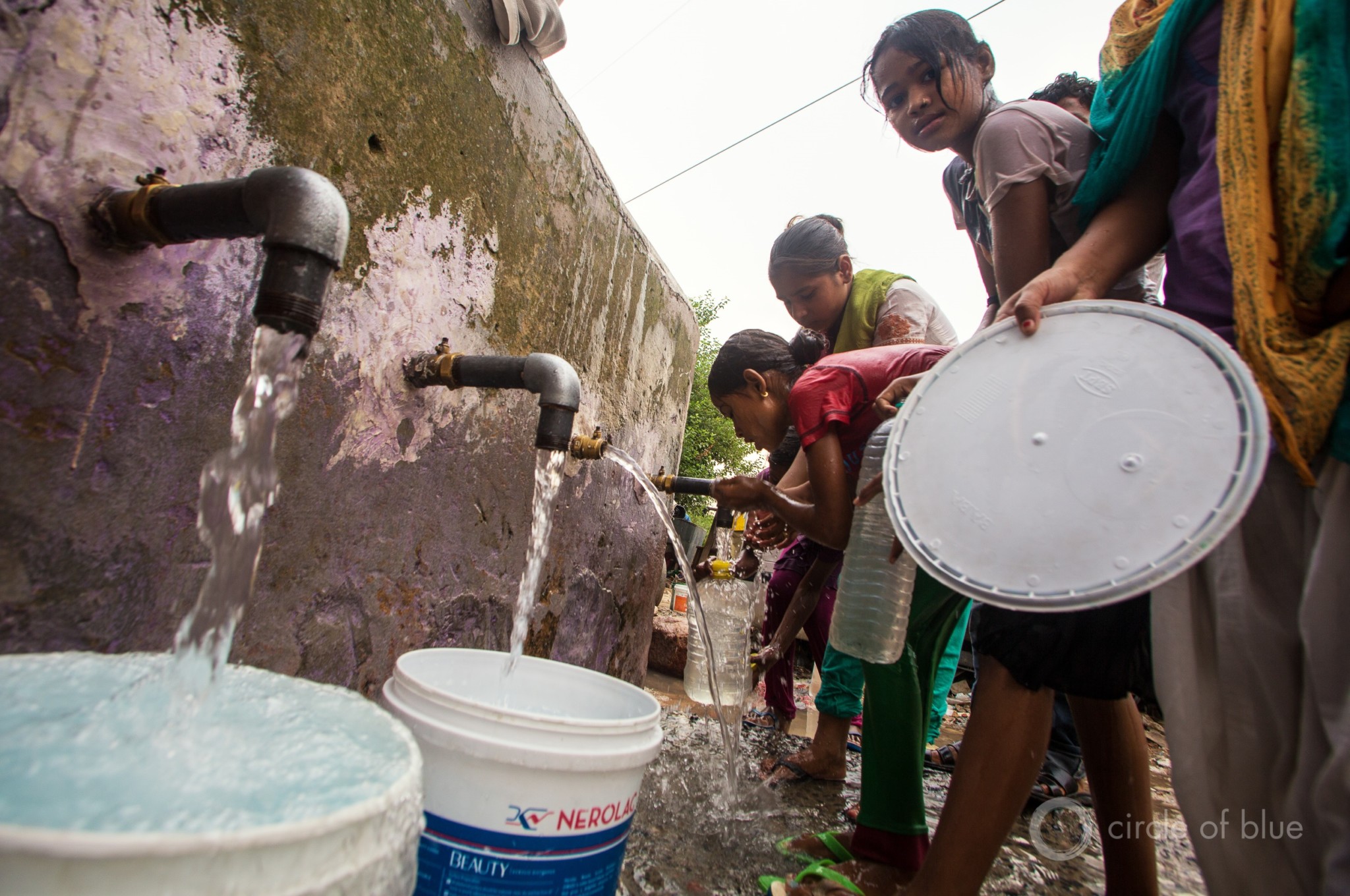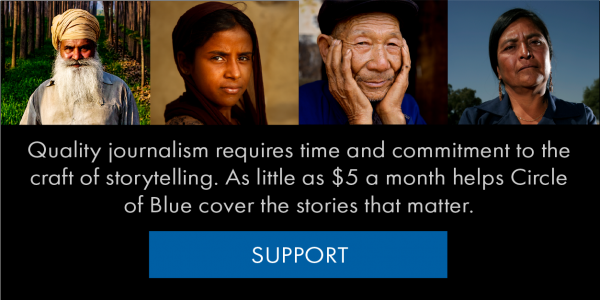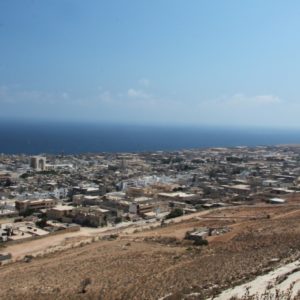Will sanitation and hygiene get lost in the organizational shuffle?

Residents in Vasant Kunj, a Delhi slum, line up to collect water that leaks from a city pipe.
By Brett Walton, Circle of Blue
A plan to reshape the administrative structure of the federal agency responsible for foreign aid is prompting questions about how to embed U.S. goals for water access, sanitation, and ecosystems into the bureaucracy’s new hierarchy.
After months of internal deliberation and following approval from the White House, the U.S. Agency for International Development publicly unveiled in mid-April a draft restructuring proposal that Mark Green, the agency’s leader, hopes will preserve USAID’s reputation as a leading international aid organization while also helping countries end reliance on foreign assistance.
“Redesign is not about a budget,” Green told staff in April. “Redesign is not in response to a budget. It’s not about staff size. It’s not about responding to a particular cause or political cause. It is, instead, going back to the idea of what we need to do to maintain our world-class leadership.”
The proposal moves the water office, along with climate adaptation programs, into a new Bureau of Resilience and Food Security. The water office is currently housed in the Bureau of Economic Growth, Education, and the Environment, which has 11 other offices and would be eliminated in the redesign.
The plan also calls for a “center of excellence” for water and a leadership council, both of which will coordinate water objectives across the agency’s programs on health, education, conflict prevention, agriculture, human trafficking, governance, and gender, as well as with outside experts.
“I want to make sure that we really take on some of the causes that we claim are important,” Green said about the centers.
The proposal’s initial rollout drew immediate criticism from water organizations. On May 1, the U.S. Water Partnership, a nonprofit that facilitates collaboration between government agencies and the private sector, noted in a letter to Green the absence of water, sanitation, and hygiene (collectively called WASH) in the titles of the reorganized bureaus. The titles, the letter acknowledged, do not tell the whole story, but they are highly influential.
“If you don’t talk about [an issue], people don’t think it’s important,” Tom Harvey, the partnership’s founder, told Circle of Blue.
The next day the nonprofit lobby group Global Water 2020 sent a letter expressing concern that WASH could be “marginalized” in the new bureau and emphasized only in relation to water’s ability to maximize food production.
John Oldfield, a Global Water 2020 group member who has discussed the redesign with administration officials, told Circle of Blue that the bureau’s food focus seemed to be “poorly aligned” with the Water for the World Act, a 2014 law that requires U.S. government water aid to prioritize health outcomes in the neediest countries. This aim is reflected elsewhere in government policy. WASH is the first objective in the administration’s global water strategy, published last October. USAID plays a leading role in carrying out the strategy.
USAID responded to the criticism by renaming the Center of Excellence for Water. It is now the Center for Water Security, Sanitation, and Hygiene.
“This decision was based on external feedback that we need to clearly signal the full scope of the Center’s mandate and responsibilities,” Annette Aulton, a USAID spokesperson, told Circle of Blue.
Building the Car, Then Finding the Driver
The problem with water at USAID has always been where to house an office that affects nearly all facets of the foreign aid enterprise. Some observers feel that assignment to the Bureau of Resilience and Food Security could give prominence to water, on which USAID spent $500 million in 2015.
“In other bureaus water risked being lost,” Lisa Schechtman, director of policy and advocacy for WaterAid, told Circle of Blue. “In the Bureau of Resilience and Food Security there are only a few programs. It gives the leader the opportunity to focus more on it, rather than if it were one of a dozen.”
Harvey also sees great potential in the decision. “For the stability and sustainability of water, I think that’s a good move. Food is getting more attention. If water is being put there because of its importance and it’s being given a high priority, I’m all for it.”
Sparked by President Trump’s March 2017 executive order to make federal agencies more “effective, efficient, and accountable,” the redesign has become Green’s initiative. The former congressman and ambassador to Tanzania was confirmed as USAID administrator in August 2017. In an administration notable for mismanagement, ethical breaches, alleged law-breaking, and incompetence, Green’s outreach to career staff and professionals outside of government has drawn praise, though some field staff felt excluded. The ultimate goal of foreign aid, he says, “must be ending its need to exist.”
Green asserts that the organizational structure is a small step in reaching that goal. The larger share comes from the work that will be done and the people who will do it. “Structure is just a tool to help us get there,” he said.
Others outside the agency also take the view that the driver is just as important as the car. “I’m not as concerned with where they put [the water office] as who they put in charge,” Harvey said. “If they pick a good leader, they can be hugely successful in driving the momentum that USAID, State Department, and private partners have been able to bring.”
The position of global water coordinator, who carries out the water mission, is not currently filled. A deputy assistant administrator is overseeing it as the acting coordinator.
The most important question, though, is one that has no answer yet: what effect will the new structure, however it shakes out, have on operations in the field?
“It’s the right question, but it’s premature,” Oldfield said. “We just do not have enough information to answer it.”
Schechtman echoed that sentiment: “It’s a good question, but it’s very much outstanding.”
For now, Global Water 2020, WaterAid, and others are working to graft water issues, in all their forms, onto the mission of the Bureau for Resilience and Food Security, the center of excellence, and the leadership council, as well as in the job description for their leaders, so that the car has the tools the driver needs.
USAID will submit its final proposal this summer to Congress, which must approve it.
Correction: This story has been updated to clarify that it is a deputy assistant administrator who is the acting global water coordinator, not an assistant administrator.
Brett writes about agriculture, energy, infrastructure, and the politics and economics of water in the United States. He also writes the Federal Water Tap, Circle of Blue’s weekly digest of U.S. government water news. He is the winner of two Society of Environmental Journalists reporting awards, one of the top honors in American environmental journalism: first place for explanatory reporting for a series on septic system pollution in the United States(2016) and third place for beat reporting in a small market (2014). He received the Sierra Club’s Distinguished Service Award in 2018. Brett lives in Seattle, where he hikes the mountains and bakes pies. Contact Brett Walton





